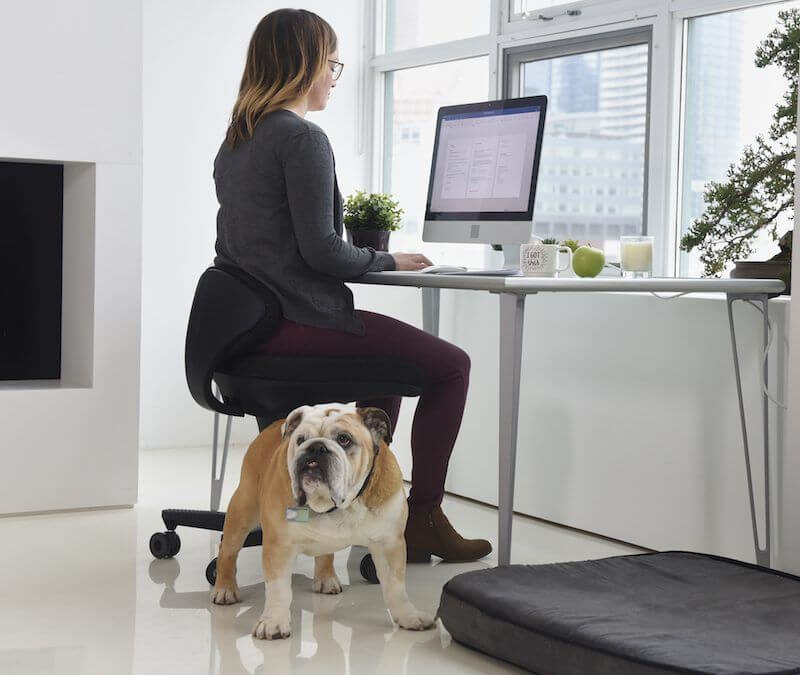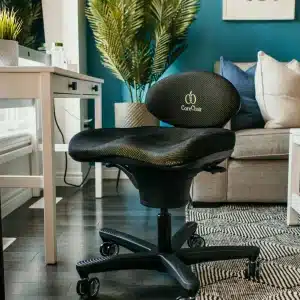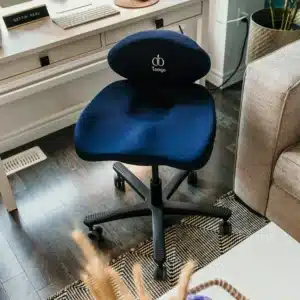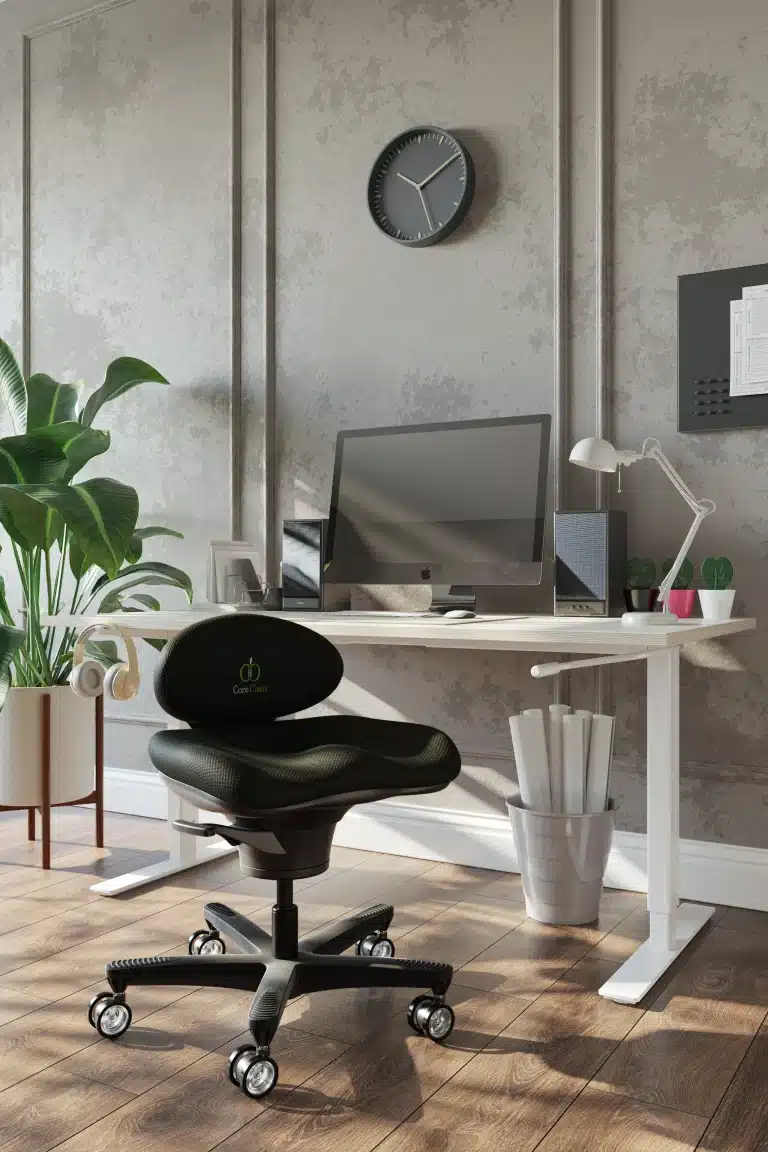We are not meant to be sedentary but when our jobs require this, we need to be certain that we are not creating problems such as back pain, by using the wrong sitting solution.
Your back pain is nobody’s business but yours but if this is affecting your productivity, comfort and your general health, then it is an important consideration for your employer as well. Back pain in general affects the vast majority of our population with reports that 80% suffer at least one significant back pain event in their lifetime and approximately 30% are currently seeking some form of therapeutic intervention. So you are not alone and industries have been pursuing solutions that can address these back pain issues with the ideal objective toward prevention.
Body awareness is the most important consideration before you seek an optimal sitting solution. Listen to your body and the telltale signs of pain and attempt to determine what is causing this pain.
There are a number of things to consider as you pursue this journey of self-evaluation. While there is a growing diversity of effective sitting solutions, it is important to keep in mind that we are all different and it is very difficult to design a solution that truly works for everyone.
The Importance of your Employees’ Back Pain
Back pain has become a very common problem and inconvenience for many people today. In fact, almost 80 percent of adults are experiencing back problems like pain and aching, especially on the lower part of the back.
With the prevalence of the condition, it is very likely that your employees are also experiencing this. Please keep in mind that back pain is a condition that must be attended immediately or it can progress into long-term injury.
When your employees are suffering from back pain, this can negatively impact the course of your business. According to studies, people who have chronic and acute back pain are normally not performing to the best of their abilities. In other words, due to the inconvenience of pain and stress, productivity and quality of work will be affected.
Unfortunately, a lot of people are claiming that their back pain and other back-related conditions are obtained from their respective jobs. And sadly, many have attested that their employers are not doing anything to alleviate the situation. As a result, this puts more strain on the company, not only on the management side but also in the actuality of the business.
So, this is why it is important that you take this aspect into consideration as well, especially if you are the owner or the one who manages the staff.
Top 5 Tips to Effectively Reduce Back Pain in the Office
Here are some of the best ways that you can help reduce the occurrence of back pain and ultimately help the employees who are suffering from the condition:
1. Consult Your Employees
As an employer or manager, it is one of your duties to get to know your employees. You should consult them about their health and wellness and allow them the opportunity to open up about how they are feeling at work.
Ask questions to find out if they are dealing with any back pain, sciatica pain, hip pain, or similar. Sometimes employees do not want to complain about their pain, however, it is necessary to be aware of this and make sure they are feeling comfortable at work to ensure optimal productivity, presenteeism, and job satisfaction.
2. Take Action After Consultation
The only way to help reduce back pain and other pain-related problems inside the office is to listen to what your employees are telling you and take action to fix the problems.
Once you’ve consulted with them, make sure that you consider all of their opinions and thoughts.
Ask them to do their own research and find different options that might help them with their pain. Make sure to also let them know that you will also create a list of options as well. Then, allow them to try all of the different options to find what works best for them.
3. Create Ergonomic Physical Environments and Workspaces
If you haven’t changed the old desk and chair sets in the office, the chances of these items causing back pain are very high. So, to avoid back pain problems, especially on your employees’ part, create a back and posture-friendly environment. Ensure that the chairs and tables are all ergonomic and properly adjusted to the proper height for the individual at each workstation.
There are different office chairs that can actually help correct and promote good posture including our favorite chair the CoreChair.
You may want to consider trialing this chair for your employees who are suffering from back pain and sitting posture issues. The company has a 60-day Risk-Free trial which allows you to purchase the chair and have your employees try it out for 60 days before committing to it. If it does not help their pain, it can be sent back within 60 days of purchase for a full refund. You can check out their return policy here.
4. Encourage Exercise
Aside from promoting an ergonomic environment in the workplace, you must also encourage your employees to help themselves with another natural pain remedy– exercise. Resolving back pain inside the office must be a two-way street. You, as an employer, provide an ergonomic space to work with, and your employees then must also help themselves.
This means that they should also put effort into changing their diet and lifestyle. You may initiate the encouragement and even consider offering a health and wellness program to include fun fitness contests, savings on their gym memberships, healthy employee lunches, etc.
There are plenty of great exercsies for increased flexibility and pain reduction.
5. Disseminate Informative Materials
Alongside the words of encouragement, another thing that you can do to reduce the apparent back pain problem among your employees is to disseminate essential information. Make them aware of the condition and give them options to avoid and alleviate it.
You can do this by sending office-wide emails with attached informative materials. You may also start pinning posters around the office featuring new innovative products, new research, and new statistics on the matter at hand.
Chair for Back pain – what do you need to pay attention to?
The first thing to check for is whether the seat is high enough or low enough to suit your employee’s needs. If you are a short person a standard height work surface is often too high and this might compromise your position, even if you have a good chair for back pain that is designed to address your height. You may need to consider a sit-to-stand desk that can be adjusted low enough when sitting.
Ideally, employees should be able to position themselves so that their elbows assume a 90-degree angle with the heels of their hands on the work surface. Less than 90 degrees will cause them to shrug their shoulders upward which over engages the muscles of your upper back and neck.
If the chair doesn’t have a height adjustable surface, your employees may need to elevate your good chair for back pain and use a foot support to assume this position. Your ideal position should place your ears over your shoulders with your upper arms hanging relaxed at your sides. Keep in mind that many low back pain situations arise from sitting in a slumped position where our pelvis is tilted back and the lumbar spine flattens.
If you need a bit more support, there are several options to consider. The first is thicker cushions and a waterfall seat. A waterfall seat has the same function as a traditional seat but has the additional benefit of reducing pressure on the back of your thigh which might otherwise restrict blood flow from your lower legs.
The appropriately designed sitting surface should provide an optimal pressure distribution to enhance sitting comfort and avoid the need for uncomfortable fidgeting. Fidgeting should not be confused with fluid movement which is very beneficial and very effective in preventing discomfort and back pain.
Consider Your Lifestyle
You have to consider what kind of lifestyle your team leads when shopping for a good chair for back pain. Do you have a pre-existing back issue? Do you have space restrictions? Are they active? Do they work remotely? Each of these factors will determine which model is right for you.
If you have a sedentary job that requires you to sit for long hours, the right chair is the best investment that you could make. Many people and employers do not take the time to fully understand and appreciate the value of a good chair for back pain.
Back pain can be extremely debilitating and very distracting for your productivity and your ability to manage your work life as well as your family and recreational aspirations.
Ideally, you will consider your entire workspace and the optimal solutions that can provide this comfort and productivity. If sitting is a primary positioning requirement, then a good chair for back pain is the priority. However, you need to consider the work surface as it relates to a sitting position, the keyboard setup to avoid RSI (repetitive stress injury) and the height of your monitor to ensure that your body is positioned with good alignment.
Weight
Weight is also a factor to take into consideration when shopping for a chair. Every chair has an ideal weight limit which means it won’t be damaged or break down if used over time by an extremely overweight person. Most chairs are designed according to universal principles which means they can accommodate a broad range of users and may require some special adjustments.
When choosing a desk good chair for back pain, make sure you’re aware of how much weight you’re likely to put on it. Light and airy fabrics won’t hurt either if you’re looking to reduce heat and humidity.
Shape
Your back is not a square, it’s curved. Make certain that you seek a chair with appropriate back support that fits your natural shape as it should ideally be when you are sitting.. The seat and back should work in harmony to fit your sit bones as well as your back with good adjustment features to accommodate changes in daily positional needs and clothing disparity.
A good chair has the right amount of giving in the back and the right amount of support in the front. If the back feels too flexible, it could lead to slouching and other back problems. On the other hand, too much give in the front could cause the user to slump forward thus putting more strain on the back. When trying to find the right shape for your back, bend it a bit and try to move around as you sit in different chairs to see which one feels best.
Style
The challenge is often whether you want something to feel good or look good. Form follows function, or function follows form.
For many a very stylish chair is an important interior design consideration but unfortunately, many very stylish good chairs for back pain are not the most effective in providing optimal positioning and relief of back pain.
It is important to clearly identify what your priority is before purchasing a chair at the risk of being disappointed by the lack of comfort.
The size of the chair is usually only an issue in tight spaces but the introduction of a low back good chair for back pain chair that is designed properly will not only take up less space but will also focus on you looking good rather than your chair.
Comfort
Comfort is the obvious priority in selecting the right good chair for back pain that your employees intend to sit in for stretches up to 8-10 hours a day. So it is important that in your journey of selection that you plan to spend more than 5-10 minutes in an attempt to evaluate how comfortable it is.
Many manufacturers offer to sell quality chairs with a satisfaction guarantee which allows the purchaser a good amount of time to truly evaluate how comfortable it actually is over real-time applications. It is important to consider comfort not just on the sitting surface but also throughout the entire back positioning including the head and neck.
It is also important to consider the comfort factor with respect to heat and humidity on the sit surfaces, especially the seat.
When evaluating comfort properly, it is important to ensure that your ergonomic workspace is also optimized and that the good chair for back pain is appropriately adjusted to complement this.
Finally, movement is medicine and a true measure of comfort in a chair would include as much healthy movement as possible without causing injury.
Once you’ve found the right chair for employees, it’s important to ensure that it offers the right support. There are several things to check for including the height of the seat as well as the backrest. Keep in mind that both of these areas should be adjustable to meet your specific needs.
This is especially important if you’re sitting at multiple desks or using a good chair for back pain at different times during the day. An ergonomic desk chair with a proper fit will bring comfort and ease to your desk jockey life.
Best chair for back pain
In our modern world of technology that was supposed to free up more casual time, we find the exact opposite to be true. People spend more time now connected to their digital devices and assume terrible postures for prolonged periods.
The outcome is a body that not only has atrophied prematurely as a result of immobility but frustrating back pain from the most common static position, sitting.
The most common response from those battling the symptoms of sitting disease is, “what is the best chair for back pain?”
In reality, all of us who have been drawn into this somewhat sedentary collapsed position of daily activities, really should be asking, “what overall strategy should I consider to deal with my back pain”?
With our dependency on technology we have also become dependent on the “quick fix” mindset and the search for the best chair for back pain, seems like the obvious solution to these distracting symptoms.
If you are one of the 25-30% of the population seeking a solution like this, it is best to begin by increasing your body awareness as the first step, to truly begin to understand why you have this back pain that appears to be the result of sitting.
While there exists a plethora of information to be found on our technology, most often it is best to seek therapeutic intervention to assist with this learning process and make suggestions as to what the best chair for back pain might be.
It is however, important that this adviser is knowledgable on various sitting solutions before making this recommendation. Their principle role is to educate you on your body awareness as well as identify the symptoms, understand the cause and prescribe appropriate therapy and lifestyle considerations.
When you begin your search for the best chair for back pain, it is important that you begin looking for a chair that has science behind the design as a first priority and style or fashion as a subsequent priority.
The best chair for back pain is the chair that focuses on your posture and is designed to promote proper body alignment.
To achieve this highest priority, the chair design must focus on the support of the pelvis. This support must consider the underside of the pelvis where your sit bones come in contact with the sit surface. This surface should provide uniform pressure distribution and create a cradle to prevent your sit bones from sliding forward on this sit surface. It must also consider the counter force by placing support on the top of the back of the pelvis.
These two points of contact, when properly designed and fitted, should position your pelvis in an upright neutral position. This pelvic position encourages your ascending spine to become more balanced with natural curves of the spine enhanced. When the spine is balanced, the need for additional upper body support is diminished.
The best chair for back pain must also include some dynamic feature that encourages movement.
The CoreChair Classic and Tango models are designed with a sculpted seat and a low pelvic support to embrace the users pelvis and maintain an upright neutral position to attain the optimal balanced sitting posture.
The CoreChair also incorporates a patented mechanism that allows for movement immediately beneath the users centre of balance to encourage this movement up to 14 degrees in all directions.
This type of movement enhances joint mobility, blood and lymphatic circulation, hydration of the intervertebral discs and stimulation of the core stabilizing muscles groups to strengthen the users core.
The best chair for back pain must address postural positioning and encourage healthy movement.
CoreChair has undergone many University based research studies that confirm the efficacy of this design.
Final Thoughts
All in all, back pain has become a real inconvenience in many businesses and is affecting employee productivity levels and their overall general health. And as an employer, you must help your employees as they are not the only ones being affected by the condition given that their overall performances are impacted. Taking the necessary steps to increase the health of your workforce and reduce the occurrence of back pain can be extremely beneficial to your company.
Like they say– healthy employees are more productive, happy, and less costly to the organization.
June Earls loves to write on various topics such as home, office diy decor. She is constantly looking for new ways to optimize her performance, and hopefully, share those experiences with her readers.










